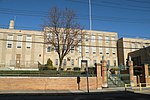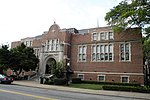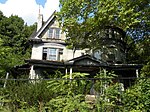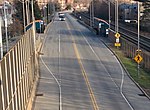Brilliant Cutoff Viaduct of the Pennsylvania Railroad
Bridges completed in 1902Bridges in PittsburghBuildings and structures in PittsburghHistoric American Engineering Record in PennsylvaniaPennsylvania Railroad bridges ... and 3 more
Railroad bridges in PennsylvaniaStone arch bridges in the United StatesViaducts in the United States

Brilliant Cutoff Viaduct of the Pennsylvania Railroad located along Washington Boulevard in the Lincoln-Lemington-Belmar/Homewood neighborhoods of Pittsburgh, Pennsylvania. It carries the Brilliant Branch, a small connector railway, and was built in 1902. It was added to the List of Pittsburgh History and Landmarks Foundation Historic Landmarks in 2003.
Excerpt from the Wikipedia article Brilliant Cutoff Viaduct of the Pennsylvania Railroad (License: CC BY-SA 3.0, Authors, Images).Brilliant Cutoff Viaduct of the Pennsylvania Railroad
Silver Lake Drive, Pittsburgh
Geographical coordinates (GPS) Address Nearby Places Show on map
Geographical coordinates (GPS)
| Latitude | Longitude |
|---|---|
| N 40.462222222222 ° | E -79.905 ° |
Address
Silver Lake Drive 99
15206 Pittsburgh
Pennsylvania, United States
Open on Google Maps










